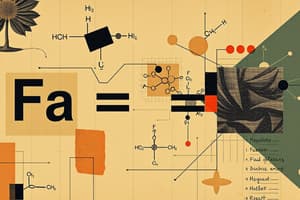Podcast
Questions and Answers
Atoms are made up of protons, electrons, and photons.
Atoms are made up of protons, electrons, and photons.
False (B)
An atom is the smallest particle of an element.
An atom is the smallest particle of an element.
True (A)
Oxygen gas (O2) is an example of a substance with monatomic molecules.
Oxygen gas (O2) is an example of a substance with monatomic molecules.
False (B)
All atoms of a given element are identical in mass and chemical properties.
All atoms of a given element are identical in mass and chemical properties.
The mass number of an atom is equal to the number of protons only.
The mass number of an atom is equal to the number of protons only.
Isotopes have the same atomic number but different mass numbers.
Isotopes have the same atomic number but different mass numbers.
In a compound, the name of the metal or positive part is written after the name of the nonmetal or negative charge.
In a compound, the name of the metal or positive part is written after the name of the nonmetal or negative charge.
Normality is defined as the number of moles of solute in 1 liter of solution.
Normality is defined as the number of moles of solute in 1 liter of solution.
Weight percent is commonly used to express the concentration of aqueous reagents.
Weight percent is commonly used to express the concentration of aqueous reagents.
Volume percent is typically used to specify the concentration of a solution prepared by diluting a solid compound with another liquid.
Volume percent is typically used to specify the concentration of a solution prepared by diluting a solid compound with another liquid.
1 ppm is equivalent to 1.00 g/L for dilute aqueous solutions.
1 ppm is equivalent to 1.00 g/L for dilute aqueous solutions.
In a compound, formulas for polyatomic ions are written without any superscripts.
In a compound, formulas for polyatomic ions are written without any superscripts.
Molarity is calculated as the number of moles of solute in 1 liter of solution.
Molarity is calculated as the number of moles of solute in 1 liter of solution.
Normality for salt is calculated based on the total number of positive or negative charges in the compound.
Normality for salt is calculated based on the total number of positive or negative charges in the compound.
Parts per Million (ppm) is commonly used to express concentrations for highly concentrated solutions.
Parts per Million (ppm) is commonly used to express concentrations for highly concentrated solutions.
Dilution involves adding more solute to increase the concentration of a solution.
Dilution involves adding more solute to increase the concentration of a solution.
Flashcards are hidden until you start studying




